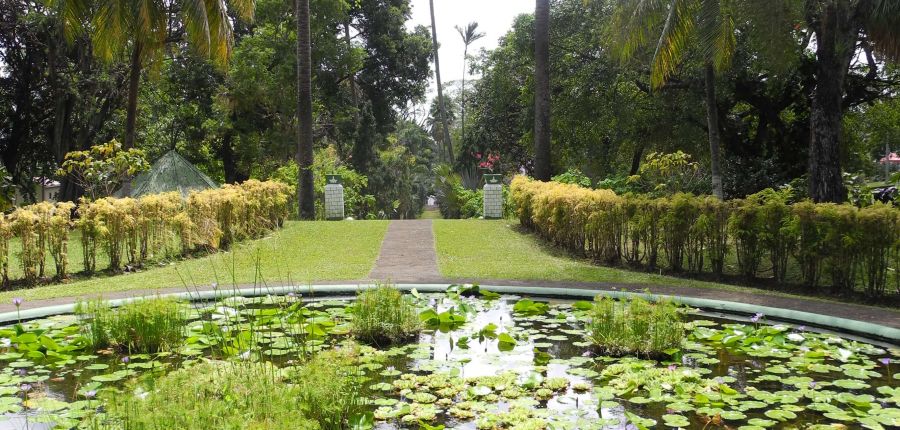Botanical Gardens, St Vincent and the Grenadines
Posted By: The Botanist Category: DesignThe Botanical Gardens on St Vincent, established in 1765, claims to be the oldest in the western hemisphere and possibly the oldest collection of tropical plants in the world. It was established six years after Kew Gardens, the aim being to create a collection of tropical plants, especially those with medicinal properties which could be used to treat diseases encountered by sailors in the British Navy when based in ‘the tropics’. The opening up of trade routes around the world in the eighteenth century fuelled the interest in exotic plants, many species of which were shipped to Kew as well as many private collections. The first person appointed as curator of the St Vincent Botanical Garden was Dr George Young, the chief medical officer of the island with a passionate interest in plants which made him the ideal person for the job.
During the 1770s and 1780s, control of St Vincent passed between Britain and France, but the Gardens continued to flourish, growing into an impressive collection of plants and trees, thanks to the hard work of George Young. Captain Bligh of HMS Bounty made his ill-fated trip to Tahiti in 1787-88 in order to collect Breadfruit and other plants which might be grown successfully in the West Indies. A year after the notorious mutiny, Bligh returned to Tahiti and completed his original mission, finally delivering Breadfruit and other plants to St Vincent in 1793 and a sucker from the original Breadfruit tree still grows in the Botanical Gardens.
˜
Maybe you will be lucky enough to visit the Botanical Gardens. St Vincent is the largest island in the Grenadines, referred to as ‘Mainland’ by people living on the smaller islands in the group. You might start your visit by travelling to St Vincent from Bequia, an hour’s journey where the sea can be quite rough even in the summer season, but the sun will shine and your fellow passengers in good spirits. Once in Kingstown - the island’s capital - take a local bus (always such fun!) to the Gardens where you will be assigned a guide and you might be fortunate to have Errol who is guaranteed to take you on a fascinating tour.
The Gardens, which cover 20 acres, are oval in shape and laid out around a central path – Hibiscus Walk - edged along its length by tall, slender palm trees, which rises steadily to a small, green-domed building, straddling the central section of the path and creating an interesting focal point. Chances are that Errol will lead you away from the path in order to show you the magnificent trees which dominate the western fringe of the Gardens: a massive Honduran Mahogany (Swietenia macrophylla); Banyan (Ficus bengalensis); towering Rubber Trees (Hevea brasiliensis) with snaking aerial roots which have woven into a dense, outer ‘skin’; and finally an immense Cannonball Tree (Courouptia quianensis) bearing huge, round ‘fruits’ which give the tree its name. When I visited, the tree was flowering – huge clusters of deep orange petals with clumps of yellow ‘eyelashes’ in the centre. You’ll then be taken back to the path and shown the collection of Hibiscus plants, hybrid varieties with stunning flowers. From here, wander on up to a large round pond, packed with lilies, papyrus and other exotics – then turn to admire the view back down the path and through the Gardens, full of magnificent trees and lush, sub-tropical vegetation.
Once in the upper reaches of the Gardens, make sure you see the famed Breadfruit trees! Then take a short detour to visit the collection of St Vincent parrots, their blue, green and yellow plumage echoed in the colours of the flag of St Vincent and Grenadines. The parrots here are being bred as part of a reintroduction programme across the island. By now you will need a short rest and much-needed refreshment, so call in to the café for an ice-cold local beer (make sure you buy your guide one…)
The rest of the tour meanders back down the western side of the Gardens, passing a collection of beautiful Crotons, numerous varieties with stunning foliage; a Jade plant (keep your fingers crossed that it will be in flower when you visit); and yet more Palms - ‘Talipot’, ‘Areca’, ‘Bottle’, ‘Travellers’, ‘Chinese Fan’, ‘Bismarck’, ‘Oil’, ‘Sago’, ‘Royal’, ‘Gru Gru’. It’s a stunning, beguiling place and you’ll be sorry when your tour finally comes to an end.
For more information about the Gardens, including lists of the 47 species of tree and 29 species of plants found there, visit the website: http://www.botanicgardens.gov.vc/







